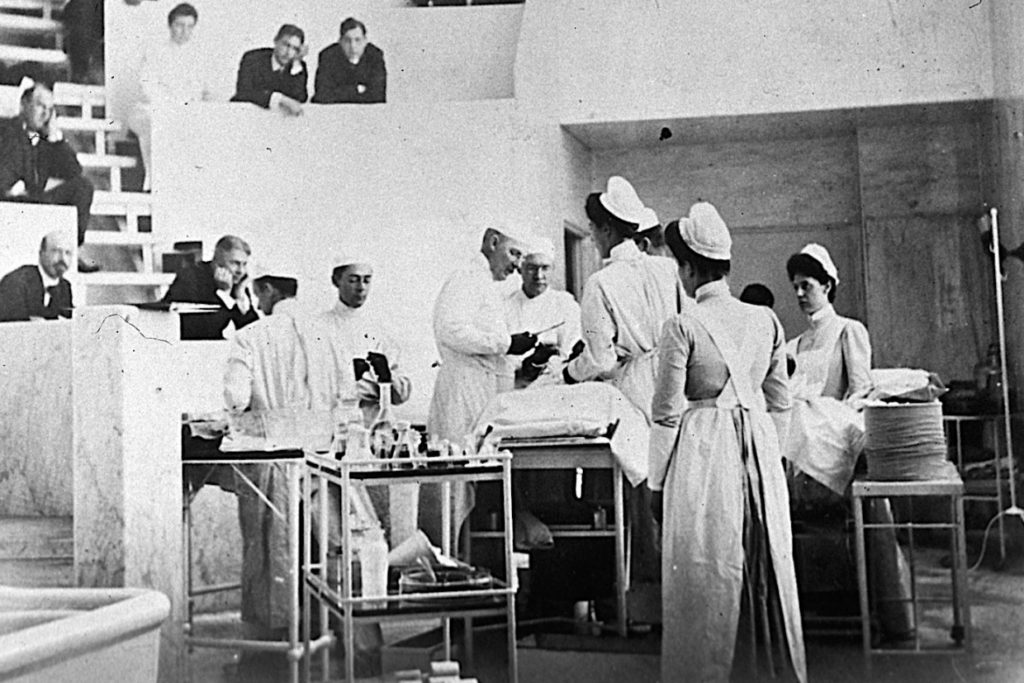Today, it is normal for health workers to wear gloves while working. But in the past, when doctors put on gloves while performing surgery, there was a fierce response. So why are gloves put into the operating room?
Trouble came from the hands of nurse Caroline
Previously, people still mentioned the name of surgeon William Halsted who introduced gloves in the operating room. But the ones who actually put the gloves in the operating room were his assistant nurses: Caroline Hampton and Joseph Bloodgood.
In 1889, Caroline worked as the main operating room nurse of the newly opened Johns Hopkins hospital, Baltimore (Maryland). Here, BS. Halsted has been hailed as one of the most talented surgeons in the country since before. He underwent training to become a good doctor in Europe, then grew up in New York. He developed new surgical methods for gallstones, thyroid, vascular and hernia diseases. BS. Halsted is also famous for having a mastectomy to treat breast cancer …

A decade earlier, BS. Halsted adopted a new theory of pathogens and implemented strict hygiene measures in the workplace. Anyone walking into the BS operating room. Halsted had to wash his hands with soap and soak his hands in a solution of potassium permanganate soda, followed by a bath with hot oxalic acid solution. Then, they washed their hands again with a mercury-chloride compound. Such over-cleaning kills germs, but also damages skin cells. Nurse Caroline was severely affected: Redness, severe eczema, and flaky patches. Aggressive but Caroline couldn’t take any more because of the pain and she resigned.
To the history of gloves in the operating room
Dr. Halsted advised Caroline to wrap her hands with a substance called Collodion (like thick syrup) to give her fingers stiffness, but it also made her fumble with work. And then the doctors came up with a solution that was supposed to be bizarre: Put on gloves. But using gloves in the operating room was now opposed by most doctors of that period. The very first gloves were created for delivery or autopsy. They have an ugly, thick, and clumsy appearance made from the intestines of sheep.
Dr. Halsted paid to buy the gloves for Caroline, then he commissioned the production of gloves for the Goodyear Rubber Company (New York). Latex gloves made for nurse Caroline were thin and covered both hands and forearms. Surprisingly, these gloves helped Caroline work so well that other nurses scrambled to buy and use them.
Joseph Bloodgood was also a pioneer in the use of gloves. Unlike Caroline wearing gloves in the operating room to protect her own hands, Joseph Bloodgood wore gloves during herniation operations and found that there was a sharp decrease in postoperative infections in the body. patient. Nurse Joseph found that 220 herniation operations were performed without gloves, 38 patients developed infectious complications (17%). But with 226 cases of gloved hernia, only 4 patients were infected (less than 2%). Nurse Joseph published his findings in 1899.
By 1911, half of all American doctors wore gloves. And BS. Halsted made it mandatory to wear gloves for anyone who entered Johns Hopkins. Until now, through the documents, people know the reason why BS. Halsted found the gloves to protect the nurse Caroline’s hands again because he secretly loved Caroline and used the gloves as a way to flirt with her. Later, Joseph Bloodgood discovered the anti-infectious effects of gloves and it was finally put into medical use as an obligatory protector.

Thus, thanks to the love of Dr. Halsted that nurse Caroline has introduced gloves into the medical, saving lives for many people.


